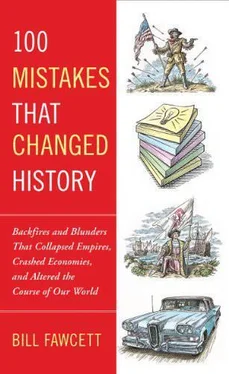In 1500, King Henry VII had two sons and two daughters. The oldest son was Arthur, expected to someday become king. His younger brother, Henry, was well-thought-of and well educated. A life in the Church as a priest was expected of Henry, with the advantage that he would not be breeding little nephews to the king who might someday become rivals for the throne. England was, at this time, a bastion of the Roman Catholic Church. In this it became the ally of Spain, ruled by the fanatically devout King Ferdinand (of Columbus fame). It was decided that rich Spain and England should draw even closer with the marriage of Arthur, heir to the English throne, to the youngest daughter of Ferdinand and Isabella, Catherine of Aragon. No one had any problems with this and when both of them were around fourteen years old (adult in those short-lived times) the two married. The problems began when Arthur died at age fifteen of tuberculosis. This left Catherine a very young widow, ten-year-old Henry the heir to the English crown, and a carefully planned political alliance that supported the pope weakened.
The solution seemed to be that Henry marry Catherine. But there was a problem. The Church had strict rules about marrying your brother’s wife. For a range of social and practical reasons, this was a serious sin. There had been too many cases when a queen was forced to marry a cousin to add legitimacy after he had grabbed the throne. Catherine had been Henry’s brother’s wife first. But the union was just too good to pass up. So both Spain and England appealed to Pope Julius II for a dispensation to allow the marriage. Effectively, this waived the sin and allowed the Church to bless the union. With all that clout behind the appeal and for a substantial share of the dowry, Julius II issued the dispensation. At the time no one was concerned that this alone weakened the validity of the marriage.
The dispensation was duly issued in 1503, but due to Henry’s youth, the wedding did not happen until June 1509. There were also rules about getting married before the marriage could be consummated. Henry had been king for two months when they married, and all seemed to be going as desired for everyone involved. At first the royal couple seemed happy. In the next nine years, Catherine bore Henry three sons and three daughters. All but one daughter, Mary, died very young. This created a problem because having a son who could inherit the throne was vital to the stability of England… and to Henry’s ego. There still was no heir. Perhaps equally important to the young, energetic, rather brilliant, and very lusty Henry VIII was that Catherine had been worn and aged by the childbearing and losses. Now, if there had been an heir or two, this would not have mattered. As even the modern generation of royals has demonstrated, taking mistresses was an accepted practice. But there was no heir, and this complicated the situation. Henry and England needed an heir, and Catherine was no longer an appealing prospect. It was likely she was also no longer capable of conceiving.
Henry took an interest in a noted beauty in the court, Anne Boleyn. Anne was young, appealing, willing, and more. With her, Henry could have his heir, and a good time. But there was a kicker. The heir could not be had from anyone but the queen. The illegitimate child of a king’s mistress could be given honors, but he could never succeed to the throne. And Henry VIII was still married to Catherine, who just happened to still be the daughter of the king of Spain. This was a major political concern as Spain was then the richest and most powerful nation in Europe.
But where love, or lust, is involved, political considerations tend to be ignored. Henry wanted Anne, and he wanted an heir, so he sent his highest-ranking cleric, Cardinal Wolsey, to ask for another favor from the pope in Rome. This time he wanted the dispensation that let him marry Catherine revoked. He wanted a dispensation from the dispensation. If there had been no original dispensation, then his marriage to Catherine would not be valid. Henry would then be free, because Catherine’s surviving daughter, Mary, would then be a bastard and no threat, and everyone would be happy… everyone except Catherine and all of Spain.
There had also been one change that complicated Henry’s plan. There was a new pope. Julius II had died and Clement was now pope in Rome. But Clement took his religious duties much more seriously than had his predecessor. The new pope also was aware of which kingdom, Spain, donated far more funds to the Church than England ever could. So after months of arguments and political maneuvering, Pope Clement ruled that the dispensation stood. Henry was, in the eyes of Rome, still married to Catherine.
The pope’s decision that he was still married put Henry in what he must have felt was a terrible position. Anne and he were already very active on a personal level, and she had pretty much put him on notice that she would stay on as queen, but not as lifetime mistress. There still remained the need to create a male heir. So Henry VIII found another way. If Rome would not allow him to dissolve his marriage, then he would dissolve his relationship with the pope. He and all of England would break away from the Roman Catholic Church. Countries and dukedoms all over Europe were doing the same thing that a part of the Protestant movement was doing.
Henry VIII would found a new church, the Church of England, which he controlled. The plan even had a second advantage. Henry needed money, and, among other things, powerful Spain was going to be angry (it was; see pages 147-152), so he was going to need a better navy and army. But England was always short of hard currency to pay for such things. If England broke with Rome, then it was okay for him to grab a fortune in Church lands and holdings. He could solve his budget problem and his marriage problem in one stroke. The new Church of England, of course, voided the dispensation, and Henry was free to marry Anne Boleyn, and four more wives later on. Henry VIII also went on to grab and sell just about every convent, monastery, and church in England.
While this new Church of England (or Anglican Church) still subscribed to many Catholic rituals and beliefs, anyone who remained a Catholic had to assume any heir he had with Anne had no right to the throne. So Catholics in England were almost immediately persecuted in the wake of Henry’s decision. In fact, the Roman Catholic churches and the priests who remained in England were illegal until well into the nineteenth century. This violent and energetic persecution of Catholics included among its victims the venerable Sir Thomas More, who years earlier had helped Henry write that book defending the Catholic Church from Martin Luther’s attacks. More was executed when he refused to attend Anne’s coronation. This was but the beginning of a cycle of violence that would persist in England for hundreds of years.
Henry VIII ended up having six wives and three true heirs (Edward, son of Jane Seymour; Mary, daughter of Catherine of Aragon; and Elizabeth, daughter of Anne Boleyn). After Henry’s demise, Edward VI took the throne but died of illness soon thereafter. Mary restored the nation to Catholicism and earned the nickname “Bloody Mary” for the hundreds of dissenters she ordered executed during her reign and the ensuing violence. Upon her death, Elizabeth took the throne, and she reestablished the Church of England.
Had Julius II not granted the dispensation, Henry would not have been married to Ferdinand’s beloved daughter, whom he felt forced to divorce later. Spain might have remained friendly to England, reversing the course of Europe for two centuries. And with England supporting Catholicism, the Protestant Reformation would have been very different and far less sweeping. An England allied to Spain and France, rather than supporting the Protestant states, would have made a military difference that would have doomed Protestantism. Henry might even have met, married, and had the heir he so desired with a woman he truly loved. This alone would have made quite a difference to the women Henry VIII did marry, saving their heads and extending their lives if nothing else.
Читать дальше












